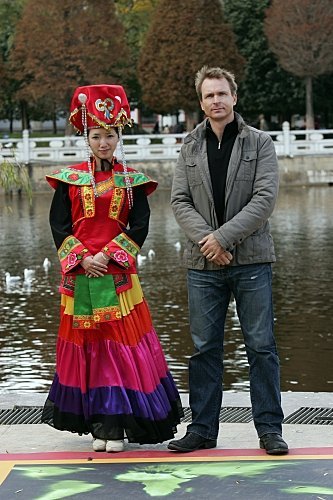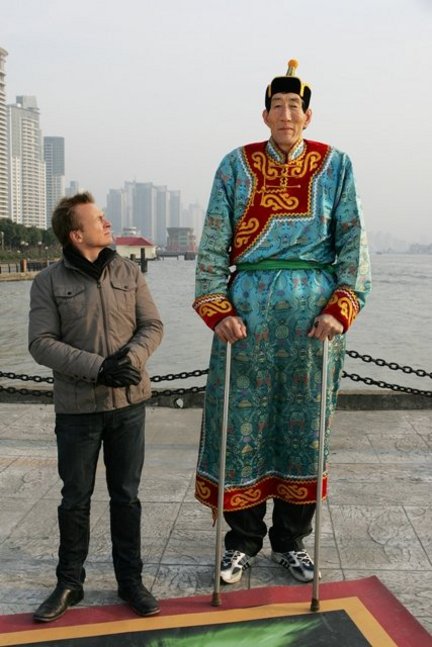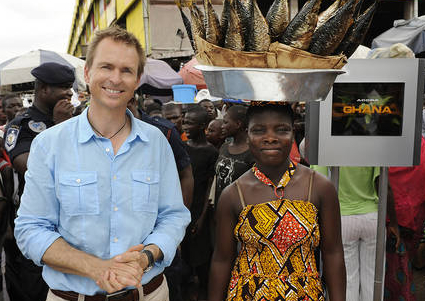Watching the World’s Amazing Races
I’m teaching Othering right now in my Media and National Identity class, and so once more Amazing Race is in my mind. Functionally, next to no other primetime shows spend as much time outside the United States, thereby making Amazing Race one of the most prominent, widely seen sites on American television for the depiction of foreign countries and peoples. And thus its representation of the world stands to “weigh” a lot more than, for instance, CSI: New York’s depiction of New York City, given the vast number of televisual depictions of the Big Apple.
What I find so frustrating about the show is not simply that it ends up Othering again and again, but that it’s a format that could allow for such interesting challenges to ideas of Othering, and that occasionally does so. It’s like a B student who writes occasionally brilliant sentences, and hence who you know could do better if s/he really applied him/herself, yet who isn’t trying hard enough.
 A key problem with televisual representations of other countries and their peoples is precisely that other countries and their people are so actively represented, by which I mean the writers and directors have very certain ideas of who they want on camera. Think of Survivor here, as perhaps the only other show on primetime American television that films overseas. The locals have been evacuated from the filming site, and are only encountered as a “reward,” and as accompaniment to the nice meal that serves as centerpiece for the reward (screaming out for bell hooks’ “Eating the Other”!). They are usually chosen for their stunning primitiveness, grass-skirts, ability to dance with a smile for the cast, and/or perhaps to impart ancient tribal lore.
A key problem with televisual representations of other countries and their peoples is precisely that other countries and their people are so actively represented, by which I mean the writers and directors have very certain ideas of who they want on camera. Think of Survivor here, as perhaps the only other show on primetime American television that films overseas. The locals have been evacuated from the filming site, and are only encountered as a “reward,” and as accompaniment to the nice meal that serves as centerpiece for the reward (screaming out for bell hooks’ “Eating the Other”!). They are usually chosen for their stunning primitiveness, grass-skirts, ability to dance with a smile for the cast, and/or perhaps to impart ancient tribal lore.
By contrast, Amazing Race holds great promise as a site for encountering the world. The format sees teams racing through towns, cities, and countryside and encountering random individuals who have not been selected by the directors (cabbie luck in particular playing a key role in who wins or loses). Especially when we’re in cities and places that the crew simply cannot stage manage, we therefore see an eclectic mix of foreigners. Their comments are of course heavily edited, and selectively translated, but they hold more power to speak for themselves, and to represent themselves. This may take place through quotidian acts like giving directions, refusing a team member’s requests to buy something in a challenge, or so forth, but it frees them from the need to appear solely as “reward,” and as dancing, cooking primitives.
Yet the Amazing Race still falls back into tired, old set pieces. Phil’s mat serves as an especially contentious site, somewhere for smiling, costumed locals to sit and wait for hours for the pleasure of welcoming Americans to their country. Phil’s allowed to look pissed off at having his time wasted, but they just sit there and smile. Oddly, we don’t even see Phil talk to them (I’m not looking for a Benetton ad, but are they that odious?). And once they’ve said “welcome,” it’s time to shut up and let Phil speak again, as their agency is so severely restricted.
 Then there are the tasks, many of which spectacularly reduce a nation to two predominant activities (“Beg or Boogie”!), and that hire a cast of colorful locals to be their very best cover-of-the-tour-book stereotypes. When the race went to Kenya, we had Masai warriors leaping up and down, in Russia it was babushkas planting potatoes (more on them in a second, though), and so forth.
Then there are the tasks, many of which spectacularly reduce a nation to two predominant activities (“Beg or Boogie”!), and that hire a cast of colorful locals to be their very best cover-of-the-tour-book stereotypes. When the race went to Kenya, we had Masai warriors leaping up and down, in Russia it was babushkas planting potatoes (more on them in a second, though), and so forth.
I’m also constantly both fascinated and depressed by the battle of looking, and of the imperial gaze, that goes on in many episodes. On one hand, the show often conforms to a “Heart of Darkness”-esque rendering of foreigners as painted onto a backdrop, mere props to draw the attention back to the American subjects, who constantly speak of and for the locals. See Chinua Achebe’s famous broadside attack on Conrad for more details on how insidious this kind of Othering is. On the other hand, the photographers often treat us to images of the foreigners staring at the American racers, and occasionally offer us delicious soundbytes of them criticizing them (as when, in a recent season, a group of babushkas engaged in wonderfully wry commentary on the racers’ plowing techniques and general physique). We’re also shown egregiously bad behavior from some racers, and the editing usually chastises the offending, offensive team. It might be easy to see this as a reminder that we’re looked at as much as the foreigners are, and at times it encourages us to look with the locals’ eyes, not the racers’. Yet there is no problematization of our own looking and gaze as viewers. The suggestion is a classically white liberal feel-good one that some travelers are bad, but that we’re not – our own motivations for watching, and investment in or at least culpability with the exoticization and spectacularization of difference, are never really questioned.
Despite all my criticism, though, I keep watching. The simple fact is that the show is doing more than most are to at least engage with the world at large. Us non-Americans don’t come out of this process looking all that good, and I’d love to reform the program in many ways (Sorry, Phil, but you’re not needed: let’s replace you with locals who can say more. How about international racing teams? And please, please, let’s do something about the challenges). But there’s potential, which is met at times. There are no tribal elimination scenes and fauxthentic team names. The soundtrack is rarely a lost recording session from Peter Gabriel. Nobody’s in jail at the hands of a brutal foreign government. The countries are more than just an amalgam of their lovely wildlife and pitiable slums. And none of them are being bombed or supposedly plotting the downfall of the USA en masse. In the radically culturally chauvinist landscape of American television, that alone puts Amazing Race in a rare position.




Very smart piece, Jonathan. You are right on about the Othering of various nations as well as the unrealized potential of the series. I think the same potential and problems exist with the way American racers are presented, too. For example, I’m touched at points this season by Margie and Luke–the mother/deaf son team, but at the same time, the program others them. How many times does the series need to show the Luke saying “Ma Ma.” That’s all he says. Most episodes don’t present him as a person. Instead, he’s reduced to a deaf kid who only says one word. So, while it’s great that the series represents a deaf person, can’t it represent him better? By contrast, Marlee Matlin is presented as a smart business woman, a good friend, and a great actress on this season of Celebrity Apprentice. Not that I want to hold The Apprentice up as a model or perfect show.
Anyway, I have the same ambivalent feelings toward The Amazing Race that you do.
Thanks for the post.
Jon
A very inspiring piece. There are a lot of areas to explore in how The Amazing Race (re)presents people and places from around the world. A study of the versions internationally might be interesting, too. As far as Jon’s comment: I thought that they did a good job showing their conversations in ASL, subtitling for tv viewers. It is notable that you notice that his “saying” “Ma” a lot– most parent/child teams are shown with the child yelling their parent’s name a lot. Christina screams “Dad” when he is slow, wanting to stop to eat, or just plain annoying her. The timbre of her articulation is just different. What is astonishing is that the Race is often touted as a metaphor for life, yet minorities and women rarely win. Is the world still designed for white men to have an advantage? As much as I don’t really care for Lakisha and Jennifer, it would be nice to see them win, if only to skewer the statistics of the winners in a positive light. Just my two cents.
Derek,
I agree with your points that minorities and women rarely win. I’d also say the elderly rarely win. Hence, I think the show is really set up for young white men to win.
Most of the challenges and the race in general favor male strength and endurance. (By contrast, some challenges on Survivor favor the physical strength and endurance of women. I knew a woman was going to win the recent “hang as long as you can” challenge before it even started. Phillip was right to not even try and head straight to the burgers.) I’d love to see an Amazing Race that had challenges based solely on life experience so that older people could trump the younger ones. The success of the younger white guys on Amazing Race has more to do with the way the show constructs challenges for an idealized competitor and less to do with the way things are in general. I’d love to see challenges that call for contestants to use minority knowledge. Why can’t challenges in the UK be set in Brixton instead of, say, near Big Ben?
Jordan Harvey wrote an excellent essay that touches on the points we’ve addressed here as well as the points Jonathan makes above. It’s called “The Amazing Race: Discovering a True American.” I think it is an anthology titled How Real is Reality TV? Harvey points out how the series others nations besides the U.S. . At the same time, the series defines American greatness in white heterosexual male terms in a way that others other versions of American identity. That is indeed the context in which I made my points about Luke. While I concede that the series does have some moments where it has him in conversations in ASL, I don’t think Luke and Margie are shown communicating as much as the other contestants. And I can’t help but compare the series to The Celebrity Apprentice, since they are running on the same night. Again, Marlee Matlin is represented as the best contestant this season. And she raised more money for her charity than anyone in the history of The Apprentice. Of course, CA isn’t an action reality series where the contestants have to race around the world, so there are no limitations on her communicating to other contestants through her sign language interpreter. I think the fast pace of AR does limit how much time it can devote to showing Luke talk in ASL., whereas it has time to pick up on the voices of other contestants as they run around in a panic. (Moreover, Marlee has an interpreter on CA, whereas you can’t have an interpreter race on AR. Hence, Margie becomes two things: a racer and an interpreter or the camera.) So, for me, as the show favors this white young, often heterosexual, male version of citizenship, it shows Luke as less than ideal because 1) parent-child teams are usually not the best teams—they are too young and old at the same time and 2) Luke is seen as less than an ideal competitor because he is still childlike, being the son on the team, and, hence, prone to emotional breakdowns (which would be expected from young people put in a situation like AR). I think while the show would pat itself on the back for representing diversity here and having a deaf contestant, I am very skeptical of its diversity and see its fixation on Luke saying “Ma Ma” as one of many othering tactics for American citizens who don’t fit the shows ideals for competitors. I would say, though, that Luke is not othered just because he is deaf. The other issues I address above are more important in the grand logic of the show. Christina and her father aren’t ideal competitors as well, and the show goes out of its way to equate them with the Asian countries on the race. While it is nice the show gives them a hybrid identity (both Asian and American), it also uses that hybridity to discount them as ideal racers.